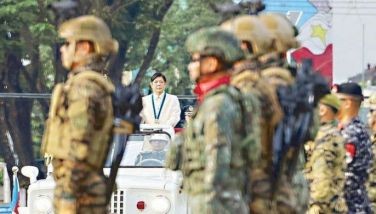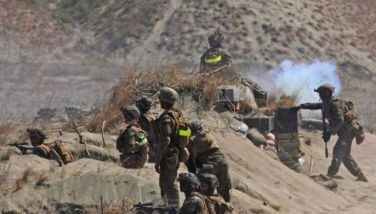A book of laughter and memory

Just launched last night at Conspiracy Bar in Quezon City is the 2015 edition of Alfred “Krip” Yuson’s The Great Philippine Jungle Energy Café. The book was first published in 1988 by the Book Development Association of the Philippines as its grand prize winner for a novel-writing contest. It ushered the Philippine novel into the wondrous world of metafiction.
Metafiction a la Yuson extends the breadth and depth of Philippine writing, for one way to capture our folk mythology and complex history – whose labyrinthine maze and sheer absurdity could make any Latin American novel read like Peanuts – is through the cosmos contained by the genre. The prefix meta means beyond. This novel is fiction, yes, but it destroys the walls and ceilings set up by realism, and frees the Filipino imagination to soar on its own.
The novel chronicles the amazing life of Leon Kilat: sacristan, Singer sewing-machine salesman, circus performer, lover, and revolutionary. Leon mirrors the Filipino’s many masks, worn because of the quirks and accidents of our history and heritage.
Yuson builds upon horizons of fictional techniques in this novel. James Joyce’s stream of consciousness in Ulysses finds a reprise here, but the resonance is clearer because more familiar. The novel also operates in a timeless universe. As National Artist Nick Joaquin observes: “In the world it creates, everything is happening under the light of eternity.”
And what a wild, eternal world it is, where Nonoy Marcelo and Jose Rizal and Edilberto K. and Edith L. Tiempo and Melchora Aquino come alive and, well, are meeting each other in a quirky coffee shop. There’s also this sleepy-eyed young man mumbling about young women and their luscious puchinggay, Paciano Rizal calling the Cuban Juan Marti “but the Baptist to my brother Pepe’s Christ,” and even our dear, much-missed Freddie Salanga, in the now-classic line from Director Peque Gallaga’s Scorpio Nights: “Ibaba ang lonta, ipakita ang ari.”
Like E.L. Doctorow’s watershed novel, Ragtime, Yuson mixes people both imaginary and real, dead or alive, where the linear concept of time itself has melted: scenes shuttle back and forth with the fluidity and grace of cinema. There are close-ups, faded outs and dissolves, and long shots. The technique implies that nothing is lost; the collective mind is a sponge that retains everything. Or as Leon Kilat himself muses: “There is strength in remembering.”
There are audacious word-plays and puns that remind us of Wilfrido D. Nolledo’s Filipino baroque magnum opus, But for the Lovers. Then there is prose which, in places, is as intricate and elegant as Nick Joaquin’s The Woman Who Had Two Navels.
But Yuson also adds his own language: at first vibrant with nervous, even erotic, energy, like the wicked excerpts he read last night; and then later, lolling about in “an imperial form of sadness.”
Rizal’s Sisa, who has become part of our mythology, surfaces again in this novel. Although no longer searching for her sons Basilio and Crispin, she still bears the gifts of grief. Listen: “To look at her though one would think she remained indifferent even to the peals of bells of sorrow.” Yuson paints scenes that are sad and beautiful. Here is a vignette on the island of Cebu, where “the sea [is] thinning off in slow seduction of unspeakable loneliness.”
But the language can also be biting, as shown in the allusion to the late dictator Ferdinand Marcos: “Presidential proclamations [were] issued as so much loaves of bread in a variety of circuses.”
And when Yuson writes of food, one’s mouth begins to water in remembrance of tastes and fragrances past: “The milkfish bellies, eels in vinegar, snipes flambed in lambanog, oh, the clear quick answer of the stomach, ahhh Maria of the catfish in cocomilk, of the crabfat with fermented shrimp rice sheathed in mustard leaf. . . .”
What to make, then, of this wild romp, this whirling dance of a novel that artist Jose “Bogie” Tence Ruiz captures so well in his new cover?
Full circle is the structure of the novel – the beginning is the end, and the end is where it begins. The novel shows our history of gladness and grief, but more of grief, for we stop moving on when the momentary light of joy has set in. What happened after the People Power Revolution at EDSA 1? The restoration of elite “democracy.” And what about EDSA 2? The downward spiral of a nation. And now, during Daang Matuwid? You tell me, buster.
Near the tail-end of the novel someone asks: “And why are we back in the revolution? and someone says ‘aren’t we always?’” That is why even our blasé millennials were shocked when they saw the film Heneral Luna. Shocked at how we treated each other like beasts, all in the name of good, ole politics.
We are a people who begin to slacken when we should have gone full steam ahead after doing something grand and revolutionary. We gather at the coffee shop to gossip, but should we not also go beyond the casual vacancy of talk and do something solid after the coffee has gone cold?
My friend, the sociologist and now lawyer Eric San Juan said that we should forge symbols that would unite us as a people. His theory of “symbolic activism” calls for alert, alive, and active symbols that would try to bind land and people, mythology and history, together, or would show the ruptures in-between these categories. The Nobel Prize winner, the late and lamented Gabriel Garcia Marquez’s lasting legacy to his Latin America is One Hundred Years of Solitude. It is both a novel – and a symbol – not only for his beloved Colombia, but also for the sprawling continent itself.
The novelists of a developing country, said one writer, has set a direction going for them: to write works that blur genres, to craft novels that are both poetry and prophecy. In short, the novelist as a visionary.
Yuson’s first and beloved first novel points that way: the kapihan symbolizes one facet of the Filipino. Amid the noise and the lunacy around him, Leon Kilat falls silent. “In his stillness Leon knew that the mysterious meant nothing else but the alternating currents of laughter and rubble.”
The novel ends with “The Resurrection.” Could our own resurrections – both as individuals and as a fractious people in this nation – lie, too, in learning how to laugh, and then moving on to build again, and yet again, from our ruins?
The Great Philippine Jungle Energy Café (2015 edition) is published by Anvil and is now available at National Book Store. Comments can be sent to danton.lodestar@gmail.com
- Latest
- Trending





























